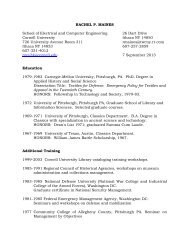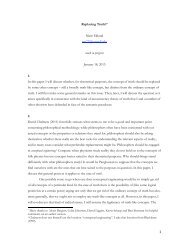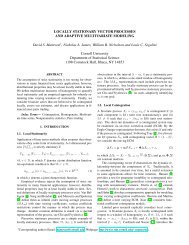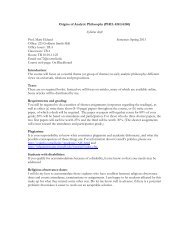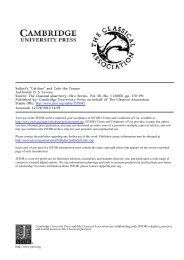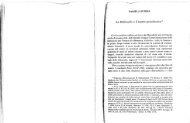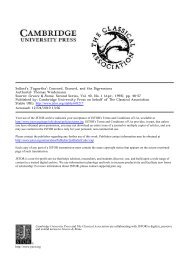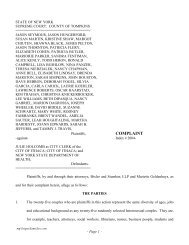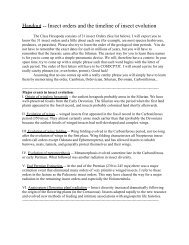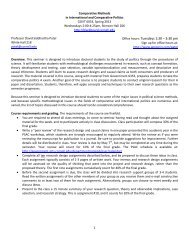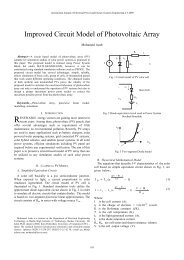Lighting level and productivity: a field study in the electronics industry
Lighting level and productivity: a field study in the electronics industry
Lighting level and productivity: a field study in the electronics industry
Create successful ePaper yourself
Turn your PDF publications into a flip-book with our unique Google optimized e-Paper software.
Ergonomics<br />
Vol. 50, No. 4, April 2007, 615–624<br />
<strong>Light<strong>in</strong>g</strong> <strong>level</strong> <strong>and</strong> <strong>productivity</strong>: a <strong>field</strong> <strong>study</strong> <strong>in</strong><br />
<strong>the</strong> <strong>electronics</strong> <strong>in</strong>dustry<br />
H. T. JUSLÉN*{, M. C. H. M. WOUTERS{ <strong>and</strong> A. D. TENNER{<br />
{Philips <strong>Light<strong>in</strong>g</strong> F<strong>in</strong>l<strong>and</strong>, Mattilantie 75, PL4, 04601, Mäntsa¨la¨, F<strong>in</strong>l<strong>and</strong> <strong>and</strong> Hels<strong>in</strong>ki<br />
University of Technology, <strong>Light<strong>in</strong>g</strong> Laboratory, F<strong>in</strong>l<strong>and</strong><br />
{Philips <strong>Light<strong>in</strong>g</strong> BV, PO Box 80020, 5600 JM E<strong>in</strong>dhoven, The Ne<strong>the</strong>rl<strong>and</strong>s<br />
The effect of illum<strong>in</strong>ance on <strong>the</strong> speed <strong>and</strong> <strong>the</strong> quality (percentage of errors)<br />
with which workers assemble electronic devices was studied <strong>in</strong> an <strong>electronics</strong><br />
factory <strong>in</strong> The Ne<strong>the</strong>rl<strong>and</strong>s. For <strong>the</strong> <strong>study</strong>, <strong>the</strong> horizontal illum<strong>in</strong>ance was<br />
alternated per work shift between 800 <strong>and</strong> 1200 lux. The first test was done<br />
dur<strong>in</strong>g <strong>the</strong> summer <strong>and</strong> a second test dur<strong>in</strong>g <strong>the</strong> w<strong>in</strong>ter. A significant effect of<br />
illum<strong>in</strong>ance has been found. With 1200 lux at <strong>the</strong> work<strong>in</strong>g plane, <strong>the</strong> speed of<br />
production <strong>in</strong> <strong>the</strong> summer was 2.9% higher than with 800 lux. In <strong>the</strong> w<strong>in</strong>ter it<br />
was 3.1% higher with <strong>the</strong> <strong>in</strong>creased illum<strong>in</strong>ance. There was no significant<br />
effect of <strong>the</strong> illum<strong>in</strong>ance on <strong>the</strong> percentage of errors.<br />
Keywords: <strong>Light<strong>in</strong>g</strong>; Productivity; Speed; Industrial environment<br />
1. Introduction<br />
The <strong>in</strong>fluence of (artificial) illum<strong>in</strong>ance on <strong>productivity</strong> has been <strong>the</strong> subject of several<br />
<strong>in</strong>vestigations dur<strong>in</strong>g <strong>the</strong> past 100 years. Recent f<strong>in</strong>d<strong>in</strong>gs of non-image-form<strong>in</strong>g, psychobiological<br />
effects via a photo-biological pathway <strong>in</strong> <strong>the</strong> bra<strong>in</strong> (Bra<strong>in</strong>ard et al. 2001,<br />
Berson et al. 2002, Hattar et al. 2002) <strong>and</strong> <strong>the</strong> <strong>in</strong>creas<strong>in</strong>g dem<strong>and</strong> for higher <strong>productivity</strong><br />
have made <strong>the</strong> issue even more important. Improv<strong>in</strong>g light<strong>in</strong>g <strong>in</strong> <strong>the</strong> workplace could<br />
have a positive effect on <strong>the</strong> performance of <strong>the</strong> workers. <strong>Light<strong>in</strong>g</strong> <strong>in</strong>fluences <strong>productivity</strong><br />
factors such as output, errors <strong>and</strong> accidents (Vo¨lker 1999, van Bommel et al. 2002).<br />
A literature search yielded several <strong>field</strong> studies <strong>in</strong> which <strong>the</strong> effect of light<strong>in</strong>g on<br />
<strong>productivity</strong> has been measured <strong>in</strong> an <strong>in</strong>dustrial environment (Ruffer 1925, 1927,<br />
Goldstern <strong>and</strong> Putnoky 1931, Schneider 1938, Bitterli 1955, Stenzel 1962a,b, Crouch<br />
1967, L<strong>in</strong>dner 1975, Carlton 1980, Buchanan et al. 1991). Most of <strong>the</strong>se studies are old<br />
but still <strong>in</strong>terest<strong>in</strong>g, although unfortunately many of <strong>the</strong>m are not very well documented.<br />
In most studies <strong>the</strong> light<strong>in</strong>g <strong>level</strong> has been <strong>in</strong>creased <strong>and</strong> <strong>the</strong> effect of <strong>the</strong> <strong>in</strong>crease on<br />
<strong>productivity</strong> has been measured. The reported <strong>productivity</strong> <strong>in</strong>creases were quite large, up<br />
to 50%. In some of <strong>the</strong> studies not only <strong>the</strong> light<strong>in</strong>g has been changed, but also o<strong>the</strong>r<br />
*Correspond<strong>in</strong>g author. Email: henri.juslen@philips.com<br />
Ergonomics<br />
ISSN 0014-0139 pr<strong>in</strong>t/ISSN 1366-5847 onl<strong>in</strong>e ª 2007 Taylor & Francis<br />
http://www.t<strong>and</strong>f.co.uk/journals<br />
DOI: 10.1080/00140130601155001
616 H. T. Jusle´n et al.<br />
factors that could <strong>in</strong>fluence <strong>productivity</strong>. In addition to illum<strong>in</strong>ance, <strong>the</strong> spectral <strong>and</strong><br />
spatial distributions of light are also important quality factors.<br />
Perhaps <strong>the</strong> most famous <strong>field</strong> <strong>study</strong> <strong>in</strong> <strong>in</strong>dustry is <strong>the</strong> Hawthorne <strong>study</strong>, after which<br />
<strong>the</strong> Hawthorne effect has been named. The Hawthorne effect (Mayo 1933,<br />
Roethlisberger <strong>and</strong> Dickson 1939, Parsons 1974) is <strong>the</strong> effect that <strong>the</strong> <strong>study</strong> or<br />
evaluation itself has on <strong>the</strong> <strong>in</strong>dividuals participat<strong>in</strong>g <strong>in</strong> that <strong>study</strong>; <strong>the</strong> feel<strong>in</strong>g of be<strong>in</strong>g<br />
observed <strong>and</strong> cared for can lead to improved performance. This effect was first revealed<br />
<strong>in</strong> studies <strong>in</strong> <strong>the</strong> relay-assembly test room of <strong>the</strong> Hawthorne plants between 1927 <strong>and</strong><br />
1932 (Parsons 1974). The duration of <strong>the</strong> work <strong>and</strong> <strong>the</strong> rest pauses were manipulated <strong>in</strong><br />
<strong>the</strong>se studies. A group of five women was separated <strong>and</strong> <strong>in</strong>tensively observed. These<br />
studies had noth<strong>in</strong>g to do with light<strong>in</strong>g. However, before <strong>the</strong>se studies, researchers had<br />
conducted three light<strong>in</strong>g studies at <strong>the</strong> same place (Parsons 1974). These light<strong>in</strong>g studies<br />
were not very well reported. They did not show a correlation between light<strong>in</strong>g <strong>level</strong> <strong>and</strong><br />
<strong>productivity</strong> (Snow 1927).<br />
The most typical <strong>and</strong> relatively easy to measure <strong>productivity</strong> parameters <strong>in</strong> <strong>in</strong>dustry are<br />
speed (or its <strong>in</strong>verse, production time) <strong>and</strong> <strong>the</strong> number of errors made. However, <strong>in</strong> many<br />
cases <strong>the</strong>se parameters are determ<strong>in</strong>ed by <strong>the</strong> function<strong>in</strong>g of <strong>the</strong> mach<strong>in</strong>es <strong>in</strong>volved or by<br />
<strong>the</strong> quality of <strong>the</strong> components that have been manufactured somewhere else. To see<br />
whe<strong>the</strong>r light<strong>in</strong>g has an <strong>in</strong>fluence on human performance, this <strong>study</strong> has been performed<br />
<strong>in</strong> a factory where <strong>the</strong> speed of <strong>the</strong> manual assembly was not determ<strong>in</strong>ed by o<strong>the</strong>r factors.<br />
The factory already had a system for record<strong>in</strong>g different k<strong>in</strong>ds of errors that could be<br />
used <strong>in</strong> <strong>the</strong> <strong>study</strong>. By chang<strong>in</strong>g <strong>the</strong> light<strong>in</strong>g <strong>in</strong> a fast, alternat<strong>in</strong>g way (almost every day),<br />
<strong>the</strong> <strong>in</strong>fluence of o<strong>the</strong>r chang<strong>in</strong>g factors was m<strong>in</strong>imized.<br />
2. Method<br />
2.1. Factory conditions<br />
In <strong>the</strong> factory concerned, electronic control gear (viz. ballasts) for gas-discharge lamps<br />
were produced. Mach<strong>in</strong>es <strong>in</strong>stalled some of <strong>the</strong> component parts before <strong>the</strong> semi-f<strong>in</strong>ished<br />
products were transported to <strong>the</strong> manual assembly area. Figure 1 shows <strong>the</strong> workplaces<br />
<strong>and</strong> <strong>the</strong> production l<strong>in</strong>es. Here, three l<strong>in</strong>es were operational, where <strong>the</strong> workers assembled<br />
<strong>the</strong> rema<strong>in</strong><strong>in</strong>g components on <strong>the</strong> circuit boards by h<strong>and</strong> (figure 1a). The number of<br />
manually <strong>in</strong>stalled components depended on <strong>the</strong> product type. The tasks were performed<br />
ma<strong>in</strong>ly <strong>in</strong> <strong>the</strong> horizontal plane.<br />
An automated sunbl<strong>in</strong>d system at <strong>the</strong> glass facade prevented direct sunlight from<br />
reach<strong>in</strong>g <strong>the</strong> production l<strong>in</strong>e closest to <strong>the</strong> w<strong>in</strong>dow (figure 1b). The light<strong>in</strong>g <strong>in</strong>stallation<br />
(figure 1c) consisted of cont<strong>in</strong>uous l<strong>in</strong>es of lum<strong>in</strong>aires (each with two 49 watt T5 lamps<br />
<strong>and</strong> a white reflector). This light<strong>in</strong>g had been <strong>in</strong>stalled at <strong>the</strong> end of 2002, a few months<br />
before <strong>the</strong> <strong>study</strong> started. The <strong>in</strong>stallation provided a horizontal illum<strong>in</strong>ance of<br />
approximately 1200 lux at <strong>the</strong> work tables. Task-light<strong>in</strong>g lum<strong>in</strong>aires were available <strong>in</strong><br />
<strong>the</strong> <strong>in</strong>spection areas, but not <strong>in</strong> <strong>the</strong> assembly area. Floor <strong>and</strong> walls were white throughout<br />
<strong>the</strong> area.<br />
There were approximately 17 workers simultaneously present on one production l<strong>in</strong>e.<br />
Depend<strong>in</strong>g on <strong>the</strong> product type, four to five of <strong>the</strong>m were work<strong>in</strong>g <strong>in</strong> <strong>the</strong> manual<br />
assembly. Three production l<strong>in</strong>es were operational dur<strong>in</strong>g <strong>the</strong> morn<strong>in</strong>g <strong>and</strong> <strong>the</strong> even<strong>in</strong>g<br />
shift. The total number of people work<strong>in</strong>g at <strong>the</strong> production l<strong>in</strong>es dur<strong>in</strong>g <strong>the</strong> test period<br />
was 119 (mean age 35 years). The participants (<strong>the</strong> manual assembly workers) were<br />
ma<strong>in</strong>ly females. The work<strong>in</strong>g schedules stayed <strong>the</strong> same dur<strong>in</strong>g <strong>the</strong> <strong>study</strong> period, <strong>and</strong> <strong>the</strong>
chang<strong>in</strong>g of <strong>the</strong> shift took place every week on Thursday. An example of <strong>the</strong> shift<br />
schedules is shown <strong>in</strong> table 1.<br />
There was no air-condition<strong>in</strong>g <strong>in</strong> <strong>the</strong> factory hall. Dur<strong>in</strong>g <strong>the</strong> w<strong>in</strong>ter period <strong>the</strong> <strong>in</strong>door<br />
temperature was constant at about 228C, but <strong>in</strong> <strong>the</strong> summer <strong>the</strong> <strong>in</strong>door temperature rose<br />
significantly, peak<strong>in</strong>g at around 20.00 hours. Figure 2 gives an example of <strong>the</strong> <strong>in</strong>door<br />
temperature curve on a day <strong>in</strong> spr<strong>in</strong>g. Dur<strong>in</strong>g <strong>the</strong> summer, <strong>the</strong> shape of <strong>the</strong> curve did not<br />
change much, only <strong>the</strong> amplitude varied.<br />
2.2. Experimental set-up<br />
<strong>Light<strong>in</strong>g</strong> <strong>level</strong> <strong>and</strong> <strong>productivity</strong> 617<br />
Figure 1. Views of <strong>the</strong> factory hall: (a) an assembly table for <strong>the</strong> circuit boards; (b) <strong>the</strong><br />
manual assembly l<strong>in</strong>e closest to <strong>the</strong> w<strong>in</strong>dow; (c) a view of <strong>the</strong> overhead light<strong>in</strong>g<br />
<strong>in</strong>stallation.<br />
To <strong>in</strong>vestigate <strong>the</strong> effect of illum<strong>in</strong>ance on <strong>the</strong> speed of manual assembly work <strong>and</strong> on<br />
<strong>the</strong> number of <strong>the</strong> errors manual assembly workers make, two light<strong>in</strong>g <strong>level</strong>s were<br />
presented to <strong>the</strong> participants follow<strong>in</strong>g an alternat<strong>in</strong>g scheme. The two <strong>level</strong>s were<br />
achieved by switch<strong>in</strong>g on <strong>and</strong> off every third lum<strong>in</strong>aire <strong>in</strong> a row. The correspond<strong>in</strong>g<br />
horizontal illum<strong>in</strong>ance at <strong>the</strong> assembly surface was 1200 lux or 800 lux <strong>and</strong> <strong>the</strong><br />
correspond<strong>in</strong>g vertical illum<strong>in</strong>ance ei<strong>the</strong>r 600 lux or 400 lux. There were two<br />
measurement periods, one <strong>in</strong> summer (5 May 2003–20 June 2003) <strong>and</strong> one <strong>in</strong> w<strong>in</strong>ter<br />
(5 January 2004–5 March 2004).
618 H. T. Jusle´n et al.<br />
Dur<strong>in</strong>g <strong>the</strong> first <strong>study</strong> period, <strong>the</strong> light<strong>in</strong>g was changed r<strong>and</strong>omly between <strong>the</strong><br />
shifts (see table 2 for part of <strong>the</strong> schedule). Dur<strong>in</strong>g <strong>the</strong> second <strong>study</strong> period (w<strong>in</strong>ter)<br />
<strong>the</strong> light<strong>in</strong>g was changed <strong>in</strong> <strong>the</strong> morn<strong>in</strong>g just before 06.00 hours (see table 3 for part of <strong>the</strong><br />
schedule).<br />
Productivity has been measured by us<strong>in</strong>g <strong>the</strong> system that was already runn<strong>in</strong>g <strong>in</strong> <strong>the</strong><br />
factory. The data of <strong>the</strong> scanners that detected <strong>the</strong> products when enter<strong>in</strong>g <strong>the</strong> manual<br />
assembly area were used to determ<strong>in</strong>e <strong>the</strong> production time. The data of <strong>the</strong> errors <strong>in</strong> <strong>the</strong><br />
manual assembly had to be extracted from error reports.<br />
After <strong>the</strong> first <strong>study</strong> period, 34 persons work<strong>in</strong>g <strong>in</strong> <strong>the</strong> factory hall completed a<br />
questionnaire. All light measurements were done after <strong>the</strong> second period.<br />
3. Results<br />
3.1. Questionnaires<br />
Table 1. Shift schedules for <strong>the</strong> workers.<br />
Schedule 1 (hours) Schedule 2 (hours)<br />
Thursday 0600–1500 1500–2400<br />
Friday 0600–1500 1500–2400<br />
Monday 0600–1500 1500–2400<br />
Tuesday 0600–1500 1500–2400<br />
Wednesday 0600–1200 1200–1800<br />
Groups change shift on Thursday morn<strong>in</strong>g.<br />
Figure 2. Example of <strong>the</strong> variation <strong>in</strong> <strong>in</strong>door temperature as a function of time <strong>in</strong> <strong>the</strong><br />
factory hall dur<strong>in</strong>g a normal day <strong>in</strong> May 2003.<br />
Figure 3 shows <strong>the</strong> results of <strong>the</strong> questionnaires. The light<strong>in</strong>g <strong>level</strong> was 1200 lux when<br />
<strong>the</strong> questionnaires were completed. The participants had to state on a 5-po<strong>in</strong>t scale to<br />
what degree <strong>the</strong>y agreed or disagreed with <strong>the</strong> statements given. Apart from <strong>the</strong><br />
questionnaire, <strong>the</strong> workers were asked whe<strong>the</strong>r <strong>the</strong>y knew that a light<strong>in</strong>g <strong>study</strong> had<br />
been go<strong>in</strong>g on dur<strong>in</strong>g <strong>the</strong> past 2 months. Even though <strong>the</strong> workers were <strong>in</strong>formed <strong>in</strong><br />
advance, 37% of <strong>the</strong>m answered that <strong>the</strong>y did not know. From <strong>the</strong> answers to <strong>the</strong><br />
questions it can be seen that <strong>the</strong> employees thought that good light<strong>in</strong>g <strong>in</strong>fluences <strong>the</strong>ir<br />
work (mean 4.2, SD 0.6). On average <strong>the</strong>y said that <strong>the</strong>y did not need more light for
<strong>the</strong>ir work (mean 2.3, SD 1.1) <strong>and</strong> that <strong>the</strong>y would like more opportunities to control<br />
<strong>the</strong> light<strong>in</strong>g <strong>in</strong> <strong>the</strong> work<strong>in</strong>g area (mean 3.4, SD 0.8). The answers to <strong>the</strong> o<strong>the</strong>r questions<br />
were on average ‘no op<strong>in</strong>ion’.<br />
3.2. Production times<br />
<strong>Light<strong>in</strong>g</strong> <strong>level</strong> <strong>and</strong> <strong>productivity</strong> 619<br />
Table 2. Part of <strong>the</strong> light<strong>in</strong>g schedule dur<strong>in</strong>g <strong>the</strong> first (summer) <strong>study</strong> period.<br />
Monday Tuesday Wednesday Thursday Friday<br />
Morn<strong>in</strong>g shift 26-May 27-May 28-May 29-May 30-May<br />
Afternoon shift 26-May 27-May 28-May 29-May 30-May<br />
Morn<strong>in</strong>g shift 2-Jun 3-Jun 4-Jun 5-Jun 6-Jun<br />
Afternoon shift 2-Jun 3-Jun 4-Jun 5-Jun 6-Jun<br />
Morn<strong>in</strong>g shift 9-Jun 10-Jun 11-Jun 12-Jun 13-Jun<br />
Afternoon shift 9-Jun 10-Jun 11-Jun 12-Jun 13-Jun<br />
Italic dates ¼ shifts with all lights on (1200 lux); bold dates ¼ shifts with one third of <strong>the</strong> lamps<br />
switched off (800 lux).<br />
Table 3. Part of <strong>the</strong> light<strong>in</strong>g schedule dur<strong>in</strong>g <strong>the</strong> second (w<strong>in</strong>ter) <strong>study</strong> period.<br />
Monday Tuesday Wednesday Thursday Friday<br />
Week 4 19-Jan 20-Jan 21-Jan 22-Jan 23-Jan<br />
Week 5 26-Jan 27-Jan 28-Jan 29-Jan 30-Jan<br />
Italic dates ¼ shifts with all lights on (1200 lux); bold dates ¼ shifts with one third of <strong>the</strong> lamps<br />
switched off (800 lux).<br />
Only product types that have been produced under both light<strong>in</strong>g conditions dur<strong>in</strong>g both<br />
morn<strong>in</strong>g <strong>and</strong> afternoon shifts have been analysed. The mean production times <strong>and</strong><br />
st<strong>and</strong>ard deviations are presented <strong>in</strong> tables 4 <strong>and</strong> 5. The mean production time has been<br />
calculated for all products for <strong>the</strong> different illum<strong>in</strong>ances <strong>and</strong> for different times of <strong>the</strong> day<br />
(morn<strong>in</strong>g <strong>and</strong> even<strong>in</strong>g shift). The product types produced dur<strong>in</strong>g w<strong>in</strong>ter <strong>and</strong> summer were<br />
not identical, so <strong>the</strong> production times of summer <strong>and</strong> w<strong>in</strong>ter cannot be compared.<br />
Different products with different production times were made on <strong>the</strong> same assembly<br />
l<strong>in</strong>e. The mean production time per product type ranged from 36 to 63 s for <strong>the</strong> summer<br />
period <strong>and</strong> from 44 to 60 s for <strong>the</strong> w<strong>in</strong>ter period. The difference is due to <strong>the</strong> fact that <strong>the</strong><br />
types <strong>and</strong> quantities of products were not equal <strong>in</strong> <strong>the</strong>se two periods. To make it possible<br />
to compare <strong>the</strong> results for <strong>the</strong> different products, <strong>the</strong> relative <strong>in</strong>crease or decrease <strong>in</strong> production<br />
time with regard to <strong>the</strong> 800 lux situation has been calculated (D ¼ (t 1200 7 t 800)/<br />
t 800, where t ¼ production time). The relative difference has been calculated per product<br />
<strong>and</strong> this dataset has been used for statistical test<strong>in</strong>g. The mean relative production speed<br />
change, where speed is <strong>the</strong> <strong>in</strong>verse of production time per product type, <strong>and</strong> <strong>the</strong> mean of<br />
<strong>the</strong>se average values, are shown <strong>in</strong> table 6 for different time spans. Three-factor ANOVA<br />
(dependent variable: production time; factors: light; shift; <strong>and</strong> product type) <strong>and</strong> planned<br />
comparison (for light <strong>and</strong> shift) were performed separately for both <strong>study</strong> periods. The<br />
statistical <strong>study</strong> results are shown <strong>in</strong> <strong>the</strong> table 7.<br />
Figures 4 <strong>and</strong> 5 show <strong>the</strong> mean relative production time change <strong>and</strong> its confidence<br />
<strong>in</strong>terval for different products dur<strong>in</strong>g both shifts <strong>and</strong> under both light<strong>in</strong>g conditions for<br />
both shifts.
620 H. T. Jusle´n et al.<br />
Figure 3. Results of <strong>the</strong> questionnaire. There were 34 completed forms (average age 36.5<br />
years, 31% male, 69% female). Scale: 1, Strongly disagree; 2, Disagree; 3, No op<strong>in</strong>ion;<br />
4, Agree; 5, Strongly agree.<br />
Table 4. Production time (mean <strong>and</strong> SD) dur<strong>in</strong>g <strong>the</strong> summer <strong>study</strong>.<br />
Summer<br />
mean (s) SD (s)<br />
1200 lux, whole days 48.9 21.3<br />
800 lux, whole days 51.5 20.9<br />
Morn<strong>in</strong>gs only 50.7 21.9<br />
Even<strong>in</strong>gs only 50.0 20.4<br />
1200 lux morn<strong>in</strong>gs 48.3 22.6<br />
800 lux morn<strong>in</strong>gs 52.5 21.1<br />
1200 lux even<strong>in</strong>gs 49.4 20.1<br />
800 lux even<strong>in</strong>gs 50.5 20.6<br />
Look<strong>in</strong>g at <strong>the</strong> simple ma<strong>in</strong> effects, <strong>the</strong>re was a significant effect for illum<strong>in</strong>ance. At<br />
1200 lux, <strong>the</strong> speed of manual assembly was higher than at 800 lux. The effect was a 2.9%<br />
<strong>in</strong>crease of production speed <strong>in</strong> <strong>the</strong> summer <strong>and</strong> 3.1% <strong>in</strong>crease <strong>in</strong> <strong>the</strong> w<strong>in</strong>ter. Dur<strong>in</strong>g <strong>the</strong><br />
w<strong>in</strong>ter, <strong>the</strong> effect was significant for both shifts <strong>and</strong> dur<strong>in</strong>g <strong>the</strong> summer for <strong>the</strong> even<strong>in</strong>g<br />
shift only. For <strong>the</strong> even<strong>in</strong>g shift <strong>in</strong> <strong>the</strong> summer, <strong>the</strong> <strong>in</strong>crease was as great as 6.3%. In <strong>the</strong><br />
w<strong>in</strong>ter <strong>study</strong>, <strong>the</strong> <strong>in</strong>crease (with <strong>in</strong>crease <strong>in</strong> illum<strong>in</strong>ance) of <strong>the</strong> production speed was<br />
4.6% dur<strong>in</strong>g <strong>the</strong> morn<strong>in</strong>g <strong>and</strong> 1.6% dur<strong>in</strong>g <strong>the</strong> even<strong>in</strong>g.
<strong>Light<strong>in</strong>g</strong> <strong>level</strong> <strong>and</strong> <strong>productivity</strong> 621<br />
Table 5. Production time (mean <strong>and</strong> st<strong>and</strong>ard deviation) dur<strong>in</strong>g <strong>the</strong> w<strong>in</strong>ter <strong>study</strong>.<br />
W<strong>in</strong>ter<br />
mean (s) SD (s)<br />
1200 lux, whole days 49.7 14.3<br />
800 lux, whole days 51.4 15.2<br />
Morn<strong>in</strong>gs only 50.9 15.1<br />
Even<strong>in</strong>gs only 50.0 14.4<br />
1200 lux morn<strong>in</strong>gs 49.8 14.4<br />
800 lux morn<strong>in</strong>gs 52.1 15.7<br />
1200 lux even<strong>in</strong>gs 49.4 14.2<br />
800 lux even<strong>in</strong>gs 50.5 14.6<br />
Table 6. Relative differences <strong>in</strong> production speed (means of product type means) due to change<br />
<strong>in</strong> illum<strong>in</strong>ance from 800 to 1200 lux.<br />
Change <strong>in</strong> production speed (%)<br />
Summer<br />
Morn<strong>in</strong>g 70.3<br />
Even<strong>in</strong>g 6.3<br />
Total 2.9<br />
W<strong>in</strong>ter<br />
Morn<strong>in</strong>g 4.6<br />
Even<strong>in</strong>g 1.6<br />
Total 3.1<br />
Table 7. Results of <strong>the</strong> three-factor ANOVA <strong>and</strong> planned comparisons.<br />
The three-factor ANOVA showed:<br />
Significant ma<strong>in</strong> effect for <strong>the</strong> illum<strong>in</strong>ance factor:<br />
Summer: F(1, 18526) ¼ 6,9406, p 5 0.01<br />
W<strong>in</strong>ter: F(1, 39004) ¼ 63,943, p 5 0.01<br />
Significant ma<strong>in</strong> effect for <strong>the</strong> product types factor:<br />
Summer: F(14, 18526) ¼ 16,512, p 5 0.01<br />
W<strong>in</strong>ter: F(9, 39004) ¼ 8,3967, p 5 0.01<br />
Significant ma<strong>in</strong> effect for <strong>the</strong> shift factor:<br />
Summer: F(1, 18526) ¼ 8,6732, p 5 0.01<br />
W<strong>in</strong>ter: F(1, 39004) ¼ 14,397, p 5 0.01<br />
Interaction between illum<strong>in</strong>ance <strong>and</strong> shift was significant for both periods:<br />
Summer: F(1, 18526) ¼ 8,7280, p 5 0.01<br />
W<strong>in</strong>ter: F(1, 39004) ¼ 15,267, p 5 0.01<br />
Interaction between illum<strong>in</strong>ance, shift <strong>and</strong> product was significant for both periods:<br />
Summer: F(14, 18526) ¼ 11,682, p 5 0.01<br />
W<strong>in</strong>ter: F(9, 39004) ¼ 12,272, p 5 0.01<br />
Univariate test for planned comparisons showed:<br />
significant difference <strong>in</strong> production time for different illum<strong>in</strong>ances for morn<strong>in</strong>g <strong>and</strong> even<strong>in</strong>g shift dur<strong>in</strong>g<br />
w<strong>in</strong>ter <strong>and</strong> for <strong>the</strong> even<strong>in</strong>g shift dur<strong>in</strong>g summer, but not for <strong>the</strong> morn<strong>in</strong>g shift dur<strong>in</strong>g summer.<br />
Summer: Morn<strong>in</strong>g: F ¼ 0,04, p ¼ 0.83<br />
Summer: Even<strong>in</strong>g: F ¼ 20,9, p 5 0.01<br />
W<strong>in</strong>ter: Morn<strong>in</strong>g: F ¼ 87,5, p 5 0.01<br />
W<strong>in</strong>ter: Even<strong>in</strong>g: F ¼ 7,0, p 5 0.01
622 H. T. Jusle´n et al.<br />
Figure 4. Summer <strong>study</strong>. The mean relative production time differences (%) (1200 lux vs.<br />
800 lux) for different products (<strong>in</strong>dicated by A–O) <strong>and</strong> shifts (vertical bars denote<br />
95% CI).<br />
Figure 5. W<strong>in</strong>ter <strong>study</strong>. The mean relative production time differences (%) (1200 lux vs.<br />
800 lux) for different products (<strong>in</strong>dicated by P–Y) <strong>and</strong> shifts (vertical bars denote<br />
95% CI).<br />
3.3. Errors<br />
Table 8 shows <strong>the</strong> relative differences <strong>in</strong> error percentages for <strong>the</strong> 1200 lux situation<br />
compared to <strong>the</strong> 800 lux situation. The error percentages of <strong>the</strong> manual assembly were<br />
very low, typically less than 1% <strong>and</strong> often 0% per shift. The changes <strong>in</strong> error percentages<br />
are not statistically significant.<br />
4. Discussion<br />
4.1. Methodology<br />
The choice to alternate <strong>the</strong> illum<strong>in</strong>ance <strong>in</strong> short periods was made to filter out potential<br />
<strong>in</strong>terven<strong>in</strong>g effects. The most important <strong>in</strong>terven<strong>in</strong>g effects are experience, motivation <strong>and</strong>
Table 8. Relative differences <strong>in</strong> error percentages due to <strong>the</strong> change <strong>in</strong> illum<strong>in</strong>ance from 800 to<br />
1200 lux.<br />
health of <strong>the</strong> manual assembly workers. It is not very likely that <strong>the</strong>se effects alternate<br />
synchronously with <strong>the</strong> light<strong>in</strong>g change scheme. The effect of be<strong>in</strong>g under <strong>study</strong><br />
(Hawthorne effect) is estimated to be very limited, because <strong>the</strong>re was no measurement<br />
equipment visible dur<strong>in</strong>g <strong>the</strong> test periods. The questionnaire results also showed that <strong>the</strong><br />
illum<strong>in</strong>ance changes were hardly noticed <strong>and</strong> certa<strong>in</strong>ly not actively discussed among<br />
<strong>the</strong> workers. Due to this approach, no conclusions can be drawn about <strong>the</strong> durability of<br />
<strong>the</strong> effects. <strong>Light<strong>in</strong>g</strong> might also affect quality of sleep, which <strong>the</strong>n would affect <strong>the</strong> next<br />
day’s performance. These longer-term effects cannot be studied with this approach.<br />
4.2. <strong>Light<strong>in</strong>g</strong> <strong>and</strong> <strong>productivity</strong><br />
The results of this <strong>study</strong> show that <strong>the</strong> light<strong>in</strong>g <strong>level</strong> had an <strong>in</strong>fluence on <strong>the</strong> production<br />
speed. The reason that <strong>the</strong>re was no significant effect for <strong>the</strong> error percentage might be<br />
caused partly by <strong>the</strong> fact that <strong>the</strong> error percentages were already very low. Ano<strong>the</strong>r<br />
reason might be that quality is a more important factor for this factory than speed. The<br />
employees were encouraged to ma<strong>in</strong>ta<strong>in</strong> <strong>the</strong> quality at all times. Differences <strong>in</strong> <strong>the</strong><br />
production speed for <strong>the</strong> different seasons <strong>in</strong>dicate that visual performance was not<br />
<strong>the</strong> only speed-<strong>in</strong>fluenc<strong>in</strong>g factor. There was no significant effect for <strong>the</strong> summer<br />
morn<strong>in</strong>gs, but dur<strong>in</strong>g <strong>the</strong> w<strong>in</strong>ter <strong>study</strong> <strong>the</strong> effect was stronger <strong>in</strong> <strong>the</strong> morn<strong>in</strong>g than <strong>in</strong> <strong>the</strong><br />
even<strong>in</strong>g. One difference between <strong>the</strong>se morn<strong>in</strong>g periods was that dur<strong>in</strong>g <strong>the</strong> summer,<br />
participants had already been exposed to bright daylight before <strong>the</strong> work<strong>in</strong>g day had<br />
begun, whereas dur<strong>in</strong>g <strong>the</strong> w<strong>in</strong>ter it was dark. The summer even<strong>in</strong>gs were <strong>the</strong> periods<br />
when <strong>the</strong> temperature <strong>in</strong> <strong>the</strong> hall was so high that <strong>the</strong>re were some compla<strong>in</strong>ts. The higher<br />
illum<strong>in</strong>ance might even have <strong>in</strong>creased <strong>the</strong> heat load <strong>in</strong> <strong>the</strong> hall, but never<strong>the</strong>less made<br />
people work faster without compromis<strong>in</strong>g quality. It could even be assumed that part of<br />
<strong>the</strong> effect was caused by <strong>the</strong> non-visual effects of light, such as direct bra<strong>in</strong> stimulation,<br />
but that rema<strong>in</strong>s speculation.<br />
The results of <strong>the</strong> questionnaire show that participants believe that good light<strong>in</strong>g<br />
<strong>in</strong>fluences <strong>the</strong>ir work, even though good light<strong>in</strong>g was not def<strong>in</strong>ed <strong>in</strong> <strong>the</strong> questionnaire. As<br />
a group, <strong>the</strong>y also answered that <strong>the</strong>y did not need more light, but would prefer more<br />
opportunities to control <strong>the</strong> light<strong>in</strong>g.<br />
5. Conclusions<br />
Change <strong>in</strong> error percentage (%)<br />
W<strong>in</strong>ter<br />
Morn<strong>in</strong>g 736<br />
Even<strong>in</strong>g 21<br />
Summer<br />
Morn<strong>in</strong>g 715<br />
Even<strong>in</strong>g 2<br />
Differences are not statistically significant.<br />
<strong>Light<strong>in</strong>g</strong> <strong>level</strong> <strong>and</strong> <strong>productivity</strong> 623<br />
Based on <strong>the</strong> results of this <strong>study</strong>, it can be said that illum<strong>in</strong>ance is one way to <strong>in</strong>fluence<br />
<strong>the</strong> speed of manual assembly under <strong>the</strong> conditions described <strong>in</strong> this paper. There was a<br />
significant <strong>in</strong>crease <strong>in</strong> speed of <strong>the</strong> manual assembly when 1200 lux horizontal light<strong>in</strong>g
624 H. T. Jusle´n et al.<br />
<strong>level</strong> was provided <strong>in</strong>stead of 800 lux. The effect was significant dur<strong>in</strong>g both <strong>the</strong> morn<strong>in</strong>g<br />
<strong>and</strong> <strong>the</strong> even<strong>in</strong>g shift <strong>in</strong> <strong>the</strong> w<strong>in</strong>ter <strong>and</strong> dur<strong>in</strong>g <strong>the</strong> even<strong>in</strong>g shift <strong>in</strong> <strong>the</strong> summer. There was<br />
no effect on <strong>the</strong> number of errors. The underly<strong>in</strong>g cause of <strong>the</strong> <strong>in</strong>crease <strong>in</strong> speed might be<br />
sought <strong>in</strong> improved visual performance or psycho-biological effects.<br />
Acknowledgements<br />
The authors wish to thank <strong>the</strong> management of Philips <strong>Light<strong>in</strong>g</strong> Electronics Oss <strong>and</strong><br />
all factory personnel for <strong>the</strong> opportunity to perform this <strong>study</strong>. Special thanks go to<br />
Rob Lamers, <strong>the</strong> <strong>in</strong>itiator of <strong>the</strong> <strong>study</strong>, who also arranged all practical issues dur<strong>in</strong>g <strong>the</strong><br />
research, to Michel Hovius for his help with <strong>the</strong> speed measurements, to Magdalena<br />
Schymanska <strong>and</strong> Erik Heermans for <strong>the</strong>ir help with <strong>the</strong> quality data <strong>and</strong> to Henk<br />
Slotman for his help with practical issues, especially dur<strong>in</strong>g <strong>the</strong> w<strong>in</strong>ter period. The<br />
assistance of Henk Verstegen, Chris Martens <strong>and</strong> Noe¨l Bonne´ of <strong>the</strong> Philips’ <strong>Light<strong>in</strong>g</strong><br />
Controls Department has been essential for <strong>the</strong> realization of <strong>the</strong> alternat<strong>in</strong>g<br />
illum<strong>in</strong>ance.<br />
References<br />
BERSON, D.M., DUNN, F. <strong>and</strong> TAKAO, M., 2002, Phototransduction by ret<strong>in</strong>al ganglion cells that set <strong>the</strong> circadian<br />
clock. Science, 295, 1070–1073.<br />
BITTERLI, E., 1955, Licht und Arbeit. Bullet<strong>in</strong> Schweizerischer Elektronischer Vere<strong>in</strong>, 46(12), 559–563.<br />
BRAINARD, G.C., HANIFIN, J.P., BYRNE, B., GLICKAMAN, G., GERNER, E. <strong>and</strong> ROLLAG, M.D., 2001, Action<br />
spectrum for melaton<strong>in</strong> regulation <strong>in</strong> humans: evidence for a novel circadian photoreceptors. The Journal on<br />
Neuroscience, 21, 6405–6412.<br />
BUCHANAN, T.L., BARKER, K.N., GIBSON, J.T., JIANG, B.C. <strong>and</strong> PEARSON, R.E., 1991, Illum<strong>in</strong>ation <strong>and</strong> errors <strong>in</strong><br />
dispens<strong>in</strong>g. American Journal of Hospital Pharmacy, 48, 2137–2145.<br />
CARLTON, B., 1980, Industrial light<strong>in</strong>g must be tailored to real-life work<strong>in</strong>g conditions. Electrical Times, issue<br />
4562, 14 March, 10–11.<br />
CROUCH, C.L., 1967, Work<strong>in</strong>g <strong>and</strong> liv<strong>in</strong>g <strong>in</strong> a lum<strong>in</strong>ous environment. Transactions of <strong>the</strong> Illum<strong>in</strong>at<strong>in</strong>g Eng<strong>in</strong>eer<strong>in</strong>g<br />
Society, 32, 41–53.<br />
GOLDSTERN, N. <strong>and</strong> PUTNOKY, F., 1931, Die wirtschaftliche Beleuchtung von Webstuhlen; neue arbeitstechnische<br />
Untersuchungen. Licht und Lampe, 22, 5–9, 25–28.<br />
HATTAR, S., LIAO, H.-W., TAKAO, M., BERSON, D.M. <strong>and</strong> YAU, K.-W., 2002, Melanops<strong>in</strong>-conta<strong>in</strong><strong>in</strong>g ret<strong>in</strong>al<br />
ganglion cells: architecture, projections <strong>and</strong> <strong>in</strong>tr<strong>in</strong>sic photosensitivity. Science, 295, 1065–1070.<br />
LINDNER, H., 1975, Beleuchtungssta¨rke und Arbeitsleistung – Systematik experimenteller Grundlagen. Zeitschrift<br />
fu¨r die gesamte Hygiene und ihre Grenzgebiete, 21, 101–107.<br />
MAYO, E., 1933, The Human Problems of an Industrial Civilization (New York: MacMillan).<br />
PARSONS, H.M., 1974, What happened at Hawthorne? Science, 183, 922–932.<br />
ROETHLISBERGER, F.J. <strong>and</strong> DICKSON, W.J., 1939, Management <strong>and</strong> <strong>the</strong> Worker (Cambridge, MA: Harvard<br />
University Press).<br />
RUFFER, W., 1925, Leistungssteigerung durch Versta¨rkung der Beleuchtung. Die Lichttechnik, 2, 53–58.<br />
RUFFER, W., 1927, Licht und Leistung. Licht und Lampe, 4, 242–245.<br />
SCHNEIDER, L., 1938, Fo¨rderung der menschlichen Arbeitsleistung durch richtige Beleuchtung. Das Licht, 8,<br />
286–296.<br />
SNOW, C.E., 1927, Research on <strong>in</strong>dustrial illum<strong>in</strong>ation. The Technical Eng<strong>in</strong>eer<strong>in</strong>g News, 8(6), 257, 272 – 274, 282.<br />
STENZEL, A.G., 1962a, Erfahrungen mit 1000 lux <strong>in</strong> e<strong>in</strong>er Lederwarenfabrik. Lichttechnik, 14, 16–18.<br />
STENZEL, A.G., 1962b, Erfahrungen mit 1000 lux <strong>in</strong> e<strong>in</strong>em Kamerawerk. Lichttechnik, 14, 351–353.<br />
VAN BOMMEL, W., VAN DEN BELD, G.J. <strong>and</strong> VAN OOYEN, M., 2002, Industriebeleuchtung und Produktivität.<br />
Tagungsb<strong>and</strong> Licht, 15, 48–58.<br />
VÖLKER, S., 1999, Eignung von Methoden zur Ermittlung e<strong>in</strong>es notwendigen Beleuchtungsniveaus. PhD Thesis,<br />
Technical University Ilmenau, Germany.



